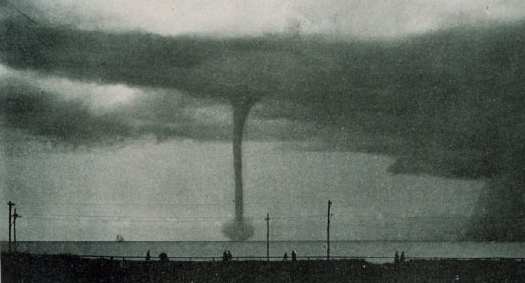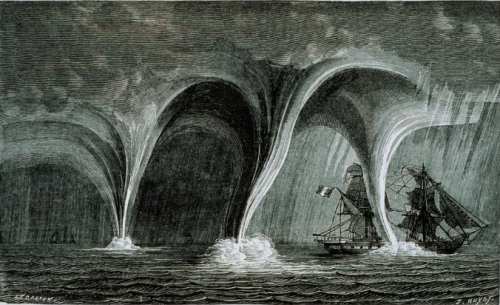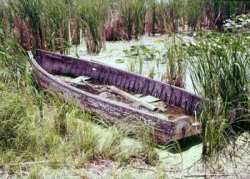 |
 |
| Home | Welcome | What's New | Site Map | Glossary | Weather Doctor Amazon Store | Book Store | Accolades | Email Us |
 | |||||||||||||||
Weather Almanac for October 2002WATER TWISTERS
I believe my first encounter with waterspouts as a concept came while reading a story or watching a television show featuring pirates of the Carribean/West Indies. Therefore, I assumed waterspouts to be tropical events. Later, I discovered that waterspouts also occur on my beloved Great Lakes, and they may form at times on the waters off my current home on the Pacific Coast, Vancouver Island. Waterspouts have a prominent place in weather lore as well as mariners and others strove to explain these fearsome weather entities. When one was seen approaching, European sailors often would cross silverware in the face of the spout to dissipate the storm or ward off its striking. The Chinese, on the other hand, believed that battling air dragons caused waterspouts. To the Winnebago tribe of Wisconsin, the waterspouts which occurred on Lake Mendota were considered to be the hero-god, Winnebozho, a "sea serpent," taking a shower bath. Though Winnebozho was generally a good-natured animal, he loved playing pranks such as overturning canoes with his body or tail, and later when white settlers moved into the area, he chased sailboats and other water craft, uprooted piers and generally frightened bathers by appearing near the beaches. Sadly, with the encroachment of science into the region, Winnebozho, like the legendary Puff, no longer came to play and faded from memory. The Waterspout
Golden defines the waterspout as a "funnel which contains an intense vortex, sometimes destructive, of small horizontal extent and which occurs over a body of water." Waterspouts fall within the class of atmospheric phenomena known as convective vortices that includes tornadoes, dust-devils, landspouts, and hurricanes. These are circulations driven by, or associated with, either dry or moist convection. Waterspouts are most common during the summer in very warm, subtropical waters, especially near island chains such as the Florida Keys. They can also be found around large lakes such as the Great Lakes during the late summer/early autumn when the lake surface waters are warmest and much cooler air crosses aloft. Before continuing, I want to narrow the discussion a bit by distinguishing between the two types of waterspouts following Tom Grazulis' definition in Significant Tornadoes. Grazulis splits them into tornadic waterspouts, which are true tornadoes formed in association with a severe thunderstorm and which happen to touch down on or cross a water surface; and true, or fair-weather, waterspouts which form over waters and dissipate almost immediately upon touching land. It is the latter form upon which I will focus herein, dropping the adjective from the name. True WaterspoutA true waterspout forms over the water and is not usually accompanied by a strong storm as is the tornadic waterspout. They commonly develop beneath lines of rapidly growing cumulus congestus clouds. These cloud lines can be quite shallow, averaging between 3600 and 430 metres (12,000 to 14,000 ft) deep with bases about 610 m (2000 ft) above the surface. The waterspout funnel forms in the rising air just ahead of any rainfall from these clouds in association with warm water temperatures and high humidity in the lowest kilometre of the atmosphere.
Waterspouts are relatively short-lived phenomena, existing only 14 to 20 minutes on average. Waterspouts travel at speeds of anywhere from 3 to 130 km/hr (2 to 80 mph), but most move at the slower end of that scale. Being small-scale circulation phenomena, waterspouts are not affected by the Coriolis force, and thus they have been observed to spin both anticlockwise (cyclonically) and clockwise (anti-cyclonically). The average waterspout is 10 to 100 metres (30 to 300 ft) in height, but can extend over 600 m (2000 ft). It measures from a metre to tens of metres (a few feet to a hundred feet) in width, and has a rotational velocity of 20 to 80 metres per second. (For comparison, tornadoes have an average height of 100 to 300 metres and a rotational velocity of 40 to 150 metres per second.) Winds within the waterspout generally reach 100 to 190 km/hr (60-120 mph). Highest waterspout winds are likely around 225 km/h (140 mph). Waterspout FormationWaterspouts most often form in the regions of high water temperatures in the Gulf of Mexico, through the Florida Straits to the Bahamas and then northward up the US East Coast following the Gulf Stream. Waterspouts have been observed to form in cyclones and anticyclones, in calm winds and in gales, in both warm and cold weather and during both night and day.
Golden distinguishes five distinct stages in a waterspout's life cycle:
Stages 1 through 4 comprise about 70 to 80 percent of the total lifetime of a waterspout. Waterspouts usually live only about fifteen to twenty minutes, and few last more than a half hour.
Although the most common structure for a mature waterspout is as a funnel with a relatively vertical orientation, there are several variations to the funnel structure. The most common waterspout variation is the multi-walled funnel. Multi-walled waterspouts consist of two or more hollow concentric tubes which may rotate at different angular velocities. Another common anomaly is the horizontal funnel. These funnels extend horizontally from the parent cloud for long distances often terminating in midair. Waterspouts have also been observed travelling form cloud to cloud, but this type of funnel is very rare. Finally, a single waterspout funnel may split into two diverging branches to form a forked waterspout. Freshwater SpoutsWhile much of what is known about waterspouts comes from observations over subtropical ocean waters, these are not the only variety. Freshwater spouts can form over any large lake or river where the water is warm and general weather conditions conducive to their formation. While the North American Great Lakes are a prime location for formation, inland waterspouts have been observed over Lake Tahoe, the Great Salt Lake and Peru's Lake Titicaca, to name just a few inland locations.
Over the Great Lakes, forecasters look at water temperature, and the temperature, moisture, and wind speed in the lowest few kilometres of the atmosphere to assess the likelihood of waterspout formation. Waterspout formation is most favourable when water temperatures are warm, the air above is cold and moist, and wind speeds are relatively light. Cool, unstable air masses passing over the warmer waters allow vigorous updrafts to form, which can tighten up into a spinning column. The cool, moist air supports a full condensation funnel despite the weaker rotation. Hazards and PranksUnlike a tornado, the funnel cloud of a true waterspout is not well defined and is considerably less destructive. Tornadic waterspouts, on the other hand, are just as dangerous as their land cousins and very often affect both land and water locations. The true waterspouts can be dangerous for boaters and shoreline locations. Smaller boats and floats are susceptible to being overturned if struck by a spout. But, due to the slow movement of waterspouts and their high visibility, ships are usually able to steer clear of them. Waterspouts are not generally a threat to modern shipping; however, some oil drilling platforms located in the Gulf of Mexico have had encounters with them. Damage to these platforms has always been minimal, and no loss of life has ever occurred.  The Great Waterspout in Vineyard Sound, August 19, 1896 (from Monthly Weather Review, July 1906) A tornadic waterspout hit Port Royal Sound in South Carolina on July 2, 1814 and sunk the US Schooner Alligator with a loss of 25 of its 40 man crew. The Lilian Morris, a sailing ship, was reportedly struck by a 500-foot-wide waterspout that tore off its masts and sails and swept a man overboard (I can find no date for this incident). In 1885, waterspouts sank five ships at Tunis on the North African coast. In 1980, a waterspout on San Antonio Bay in Texas struck a shrimp boat, flipping it over before it sank.  Trombes A sailing vessel in peril from multiple waterspouts From: Les Meteores, Margolle et Zurcher, 3rd Ed., 1869 Waterspouts, likely those of the tornadic variety, have been known to occasionally suck up live fish and frogs and then drop them over nearby land. In Montreal, a waterspout once rained lizards on the city. They have also showered tadpoles on New York and toads on France. A waterspout which struck Providence, Rhode Island, rained fish down on the populus who promptly gathered and sold them, a heaven-sent windfall for sure! All images of waterspouts in this article courtesy NOAA Photo Library, NOAA Central Library, US Department of CommerceLearn More From These Relevant Books
|
|||||||||||||||
 |
To Purchase Notecard, |
Now Available! Order Today! | |
 |
 |
NEW! Now |
The BC Weather Book: |


